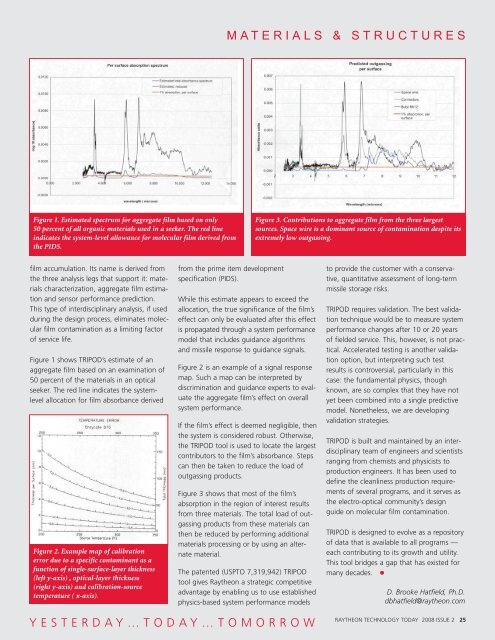2008 Issue 2 - Raytheon
2008 Issue 2 - Raytheon
2008 Issue 2 - Raytheon
Create successful ePaper yourself
Turn your PDF publications into a flip-book with our unique Google optimized e-Paper software.
Figure 1. Estimated spectrum for aggregate film based on only<br />
50 percent of all organic materials used in a seeker. The red line<br />
indicates the system-level allowance for molecular film derived from<br />
the PIDS.<br />
film accumulation. Its name is derived from<br />
the three analysis legs that support it: materials<br />
characterization, aggregate film estimation<br />
and sensor performance prediction.<br />
This type of interdisciplinary analysis, if used<br />
during the design process, eliminates molecular<br />
film contamination as a limiting factor<br />
of service life.<br />
Figure 1 shows TRIPOD’s estimate of an<br />
aggregate film based on an examination of<br />
50 percent of the materials in an optical<br />
seeker. The red line indicates the systemlevel<br />
allocation for film absorbance derived<br />
Figure 2. Example map of calibration<br />
error due to a specific contaminant as a<br />
function of single-surface-layer thickness<br />
(left y-axis) , optical-layer thickness<br />
(right y-axis) and calibration-source<br />
temperature ( x-axis).<br />
from the prime item development<br />
specification (PIDS).<br />
While this estimate appears to exceed the<br />
allocation, the true significance of the film’s<br />
effect can only be evaluated after this effect<br />
is propagated through a system performance<br />
model that includes guidance algorithms<br />
and missile response to guidance signals.<br />
Figure 2 is an example of a signal response<br />
map. Such a map can be interpreted by<br />
discrimination and guidance experts to evaluate<br />
the aggregate film’s effect on overall<br />
system performance.<br />
If the film’s effect is deemed negligible, then<br />
the system is considered robust. Otherwise,<br />
the TRIPOD tool is used to locate the largest<br />
contributors to the film’s absorbance. Steps<br />
can then be taken to reduce the load of<br />
outgassing products.<br />
Figure 3 shows that most of the film’s<br />
absorption in the region of interest results<br />
from three materials. The total load of outgassing<br />
products from these materials can<br />
then be reduced by performing additional<br />
materials processing or by using an alternate<br />
material.<br />
The patented (USPTO 7,319,942) TRIPOD<br />
tool gives <strong>Raytheon</strong> a strategic competitive<br />
advantage by enabling us to use established<br />
physics-based system performance models<br />
YESTERDAY…TODAY…TOMORROW<br />
MATERIALS & STRUCTURES<br />
Figure 3. Contributions to aggregate film from the three largest<br />
sources. Space wire is a dominant source of contamination despite its<br />
extremely low outgassing.<br />
to provide the customer with a conservative,<br />
quantitative assessment of long-term<br />
missile storage risks.<br />
TRIPOD requires validation. The best validation<br />
technique would be to measure system<br />
performance changes after 10 or 20 years<br />
of fielded service. This, however, is not practical.<br />
Accelerated testing is another validation<br />
option, but interpreting such test<br />
results is controversial, particularly in this<br />
case: the fundamental physics, though<br />
known, are so complex that they have not<br />
yet been combined into a single predictive<br />
model. Nonetheless, we are developing<br />
validation strategies.<br />
TRIPOD is built and maintained by an interdisciplinary<br />
team of engineers and scientists<br />
ranging from chemists and physicists to<br />
production engineers. It has been used to<br />
define the cleanliness production requirements<br />
of several programs, and it serves as<br />
the electro-optical community’s design<br />
guide on molecular film contamination.<br />
TRIPOD is designed to evolve as a repository<br />
of data that is available to all programs —<br />
each contributing to its growth and utility.<br />
This tool bridges a gap that has existed for<br />
many decades.<br />
D. Brooke Hatfield, Ph.D.<br />
dbhatfield@raytheon.com<br />
RAYTHEON TECHNOLOGY TODAY <strong>2008</strong> ISSUE 2 25
















